
10/13/6 - 10/22/6
john benjamin cribbs
In October 2006, Funderburg and Cribbs set out to watch at least 200 movies over the course of the next 200 days. They both watched a different slate of films and wrote about every single one; from epic high art masterpieces such as Jean-Pierre Melvile's Army of Shadows to half-forgotten oddities like I Bury the Living to quality-deficient garbage like Charles Band's Tourist Trap. In sections spanning 10 days at a time, The Pink Smoke is reprinting their writings about the grueling experiment in cinematic endurance.
10.13.06. The Woods.
 Most of the new wave of horror filmmakers - Eli Roth, Rob Zombie, Neil Marshall - are on their second film, and Lucky McKee's follow-up to May seems to have snuck in under the radar. Agnes Bruckner (a Claire Danes/Sco-Jo hybrid) plays a troubled youth circa-1965 who because she "enjoys setting fires" is dumped at the Fallburn Academy for girls run by an eerie set of teachers: Patricia Clarkson, a twitching Marcia Bennett, and a third who looks kind of like Scott Thompson in drag. My inital reaction was that the feel of The Woods was right: Argento's Suspiria mixed with the creeping anxiety of the scary sanitarium scenes from Return to Oz. McKee's favorite themes are present: female relationships, awkward social behavior and intangible threats from inanimate objects (in this case...trees), and lord knows I miss bloody axes in horror movies (the main appeal of 2001's Frailty.)
Most of the new wave of horror filmmakers - Eli Roth, Rob Zombie, Neil Marshall - are on their second film, and Lucky McKee's follow-up to May seems to have snuck in under the radar. Agnes Bruckner (a Claire Danes/Sco-Jo hybrid) plays a troubled youth circa-1965 who because she "enjoys setting fires" is dumped at the Fallburn Academy for girls run by an eerie set of teachers: Patricia Clarkson, a twitching Marcia Bennett, and a third who looks kind of like Scott Thompson in drag. My inital reaction was that the feel of The Woods was right: Argento's Suspiria mixed with the creeping anxiety of the scary sanitarium scenes from Return to Oz. McKee's favorite themes are present: female relationships, awkward social behavior and intangible threats from inanimate objects (in this case...trees), and lord knows I miss bloody axes in horror movies (the main appeal of 2001's Frailty.)
Unfortunately there are some glaringly bad aesthetic choices. You got disembodied whispers from the forest, slinking CG-generated fog, reverberating voices on actors - stuff that just isn't scary and is played out repeatedly in the film. One particularly bad decision is McKee's use of the old three shot cut-in reveal of a dead body with synchronizing music cue (I can't really describe it any better, but see the end of the "Simpsons" Australia episode for reference*.) There are no surprises, which is something horror movies really need, and McKee plays all his cards in the first thirty minutes. I'd also accuse him of casting Bruce Campbell for the sake of casting Bruce Campbell if I didn't love seeing Campbell in pretty much anything. It's nothing completely damning to McKee - there's every indication that he may have lost creative control of the film at some point and might have a better showing next time around.
* Thanks to Chris for actually listening to the commentary of this "Simpsons" episode to clarify: that technique is called a "smash zoom."
10.14.06. Deathdream.
(aka Dead of Night aka Nightwalk aka The Night Andy Came Home aka The Veteran aka Whispers)
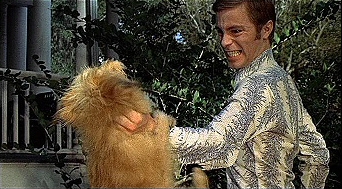
I love movies with millions of titles, and the dvd restoration of this 1974 film chose "Deathdream," the most appropriate (though the opening titles still read "Dead of Night," confusingly.) The film feels like a fever nightmare, a dream-come-true gone wrong, and the feeling bleeds through the center of every scene. Beating Romero's Martin by 3 years (this was one of Tom Savini's first make-up gigs), Bob Clark made this story of modern vampirism about 21-year-old Andy Brooks returning home after a tour in Vietnam...where he was killed in action. His parents, played by John Marley and Lynn Carlin (Richard and Maria from Faces!), are relieved to have him back, until corpses start to turn up with jagged scars across their necks and needle marks in their arms.
Cited as being one of the first movies to deal with 'Nam's less-than-glamorous effects, Clark's film (written by Alan Ormsby, who directed the Ed Gein-inspired Deranged and also wrote the great My Bodyguard) is both an updating of W.W. Jacob's short story "The Monkey's Paw" - a study in the acceptance of death which Stephen King's Pet Semetery and Joe Dante's Masters of Horror segment "Homecoming" would ape years later - and a parable about how post-war trauma infects an ignorant homestead like a virus. The sets, costumes and characters are specifically pre-war America: victims include a friendly truck driver, the town doctor and the make-out happy patrons of a drive-in movie theater. The point's clear: nothing can be the same. Watching it made me miss the kind of broad, bizarre performances actors could get away with in material like this and Clark's other 70s horror films, Children Shouldn't Play with Dead Things and Black Christmas, behaving like weird, overgrown children. The climatic chase scene involving a flaming car is also pretty wild.
10.15.06. Street Trash.
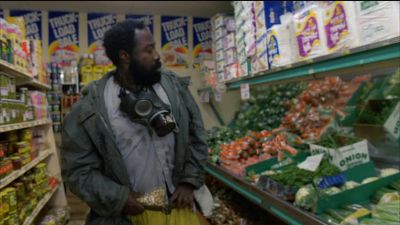 I reserve the word "masterpiece" for movies like Jim Muro's Street Trash, movies I get excited watching. Written and produced by Roy Frumkes (the first zombie to get a pie in the face in the original Dawn of the Dead) and most comparable to Repo Man or Larry Cohen's The Stuff, this environmental horror-comedy feels like what would happen if anyone at Troma knew how to make a movie.* It finds humor and pathos in castration, necrophilia, melting flesh and exploding bodies and contains probably one of the top three great exploding body scenes. The best movie featuring homeless protagonists since Boudou Saved from Drowning, Street Trash follows the derelicts living in a salvage yard and their struggles against the immoral lot owner, the mafia, their psychotic, tyrannical dictator Bronson (a former hit man in Vietnam with a knife made from a human femur bone) and, most importantly, a case of 60-year old booze called Viper which, unbeknownst to our heroes, dissolves the human body into a volcano of sizzling purple and green liquids in about 60 seconds.
I reserve the word "masterpiece" for movies like Jim Muro's Street Trash, movies I get excited watching. Written and produced by Roy Frumkes (the first zombie to get a pie in the face in the original Dawn of the Dead) and most comparable to Repo Man or Larry Cohen's The Stuff, this environmental horror-comedy feels like what would happen if anyone at Troma knew how to make a movie.* It finds humor and pathos in castration, necrophilia, melting flesh and exploding bodies and contains probably one of the top three great exploding body scenes. The best movie featuring homeless protagonists since Boudou Saved from Drowning, Street Trash follows the derelicts living in a salvage yard and their struggles against the immoral lot owner, the mafia, their psychotic, tyrannical dictator Bronson (a former hit man in Vietnam with a knife made from a human femur bone) and, most importantly, a case of 60-year old booze called Viper which, unbeknownst to our heroes, dissolves the human body into a volcano of sizzling purple and green liquids in about 60 seconds.
Muro, who operated steadicam for Henenlotter's Brain Damage, Maniac Cop, and later for James Cameron, Oliver Stone and Martin Scorsese (now working as a cinematographer, he shot last year's Crash and worked on Michael Mann's Miami Vice) directs with a dazzling fluidity, attention to detail and continuity and exciting pacing similar to early Peter Jackson. It's a shame this was his only directorial effort, because the movie is a rare entertainment, lots of fun. I watched the scene where Burt goes shopping three times. I thought Brain Damage's blow job/brain-sucking was unrivaled, but the penis keep-away scene from this film is worthy competition for most outrageous gross-out of all time.
*Hard to say why Lloud Kaufman specifically refers to Muro as "Troma's most hated director" in his book. Is it just because Street Trash is that much better than Toxic Avenger? Or does he just see it as a rip-off? I'd be curious to find out.
10.16.06. Vanishing Point.
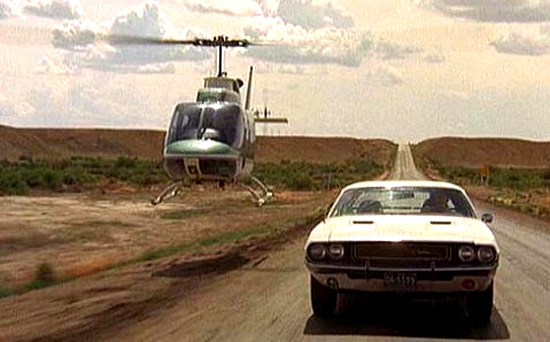
In what must be the world's most existential road movie (sorry Wim Wenders), the spectacle of "Dukes of Hazzard"-style stunts and the twangs of banjo getaway music are surface to a story of fatalistic soul searching. Throughout the film, the driver is pushing his white 1970 Dodge Challenger - but on the extending roads of the sprawled American west, the horizon never gets any closer. Barry Newman plays Kowalski, a Vietnam vet and former cop with curly hair, a five o'clock shadow and cool vest that made me wonder what it would have been like if Elliot Gould had played Han Solo. Hoped up on speed, on a mission to "get to Frisco," he stays ahead of three states' worth of highway patrol, all the while championed by blind DJ Super Soul played with manic greatness by Cleavon Little.
Between encounters with scary religious freaks, psychotic queers and a beautiful phantom hitchhiker (Charlotte Rampling), Kowalski looks back at his past while ripping towards the desolate future. It's a sensation the film captures perfectly (handled a little less poignantly, perhaps, by the "Burning Heart" montage of Rocky IV) - how being alone with the perpetual drone of a car engine ignites a self-reflection channeling from the mind to the intense grip on the steering wheel, personal memories forcing the driver absurdly forward. These moments, the best in the movie, have the compelling power of a silent film: the desperate feeling of isolation you get from the characters in McCabe and Mrs Miller during a Leonard Cohen ballad. It's a bit psychotic and more than a little romantic how the passion urging Kowalski - dubbed the "last American hero" by Super Soul - ominously forebodes the climax and imposes the idea that a man could ride forever.
10.17.06. The Death of Mr. Lazarescu.
Cristi Puiu has been compared - mostly by himself - to Eric Rohmer, and Death of Mr. Lazarescu is the first of a proposed series of films inspired by the "Six Moral Tales." It's funny because, technically, the two couldn't be any different: Rohmer has a quiet, invisible fashion of filmmaking and his characters speak in long, rich dialogues. Puiu films Lazaresu in the style of that "din" genre of European art films, all living atmosphere captured in shaky, "aware" camera movements and public ambience in which the people on screen improvise over each other, looking around as if for some form of direction. Lazaresu is about an older guy who's pitifully dependent and probably smelly, and he's moved from one hospital room to the next, his complaints of pain never taken too seriously, in a ludicrous journey meant to point fingers at the health care system and its cold, uncaring staff.
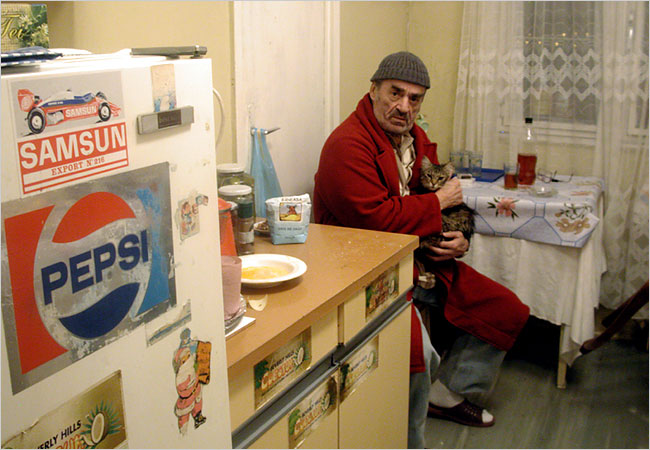 The movie's broad implications don't work for the simple reason that the old man is a bit of a tedious whiner, whose symptoms are erratic and badly communicated by the patient (they range from headache to stomach pain to bloody threads in his vomit.) Maybe this comes from working in a hospital myself, but the film's evidence of a faulty health care system (and there's a lot of it, in America at least) can't be hung on individual sadistic doctors and miscommunication when a patient is turned over from one unit to the next, especially when there is a kindhearted paramedic who sticks with Mr. Lazaresu all night and even goes above and beyond her duty to get him into an x-ray. This is the worst kind of cinematic lecturing, the kind done in cold documentary "real time" style, a voiceless sermon, while knowingly making references to Dante and the story of Lazarus - things to make people feel smart while they're watching the movie, and make the filmmaker seem smart consequently.
The movie's broad implications don't work for the simple reason that the old man is a bit of a tedious whiner, whose symptoms are erratic and badly communicated by the patient (they range from headache to stomach pain to bloody threads in his vomit.) Maybe this comes from working in a hospital myself, but the film's evidence of a faulty health care system (and there's a lot of it, in America at least) can't be hung on individual sadistic doctors and miscommunication when a patient is turned over from one unit to the next, especially when there is a kindhearted paramedic who sticks with Mr. Lazaresu all night and even goes above and beyond her duty to get him into an x-ray. This is the worst kind of cinematic lecturing, the kind done in cold documentary "real time" style, a voiceless sermon, while knowingly making references to Dante and the story of Lazarus - things to make people feel smart while they're watching the movie, and make the filmmaker seem smart consequently.
The movie's also been called a black comedy, but I thought those were supposed to be funny. It's when the film is less interested in probing structural breakdown (and it mostly is, Puiu says so in a documentary while comparing himself to Rohmer) and more involved in character that it gets interesting. The longer the night goes (and it does go on, this is a 2 1/2 hour movie...the netflix sleeve claimed an hour forty like it was trying to trick me or something), the more humiliating and torturous it becomes for the hero who ends up nude, his head shaven, begging miserably to be allowed to use the toilet, to wash. The indignity of a public death is the real horror of the film, and it's those moments that are wretchedly watchable: Lazarescu doesn't deserve this degradation, no matter how obnoxious he is. One other note: this dvd had the worst subtitles I've ever seen, embroidered-blue English that made my eyes burn reading them. I should've just learned Romanian...
10.18.06. The Break-Up.
 It was hard for me to see this movie: Vince Vaughan has long had my vote for actor most deserving of shovel decapitation/burial and I've missed several movies I otherwise would've sat through due to his presence. However, I'm a fan of the underrated Peyton Reed ("Mr. Show," Bring It On, Down with Love) and since I did pay to see the Fantasic Four movie even though he didn't end up directing it, I felt like I owed it to him to see this. And it's not too bad - it just suffers from a baffled supporting cast who must have thought they signed on for a comedy instead of a relationship drama. The studio definitely tried to sell it as such: scenes that seemed all zany and screwbally in the preview are stone-faced serious in the actual film, different shots are even used in the final product than in the trailer.
It was hard for me to see this movie: Vince Vaughan has long had my vote for actor most deserving of shovel decapitation/burial and I've missed several movies I otherwise would've sat through due to his presence. However, I'm a fan of the underrated Peyton Reed ("Mr. Show," Bring It On, Down with Love) and since I did pay to see the Fantasic Four movie even though he didn't end up directing it, I felt like I owed it to him to see this. And it's not too bad - it just suffers from a baffled supporting cast who must have thought they signed on for a comedy instead of a relationship drama. The studio definitely tried to sell it as such: scenes that seemed all zany and screwbally in the preview are stone-faced serious in the actual film, different shots are even used in the final product than in the trailer.
It starts off as the kind of shallow he-said she-said battle of the sexes: Vaughan likes playing video games, Aniston has to cook the big meal for the family gathering. But it quickly gets much smarter about communication in a relationship, how what one person wants means something entirely different to the person they want it from. It becomes about why relationships fail, and also about the awkwardness of having to be around arguing couples (and some of the fights are brutal.) It picks up on things like girls who say they don't want flowers but really do; how spats quickly devolve into ridiculing each other's speech and letting out pent-up hatred of family members.
It's a good medium for Jennifer Aniston, somewhere between the intelligence of The Good Girl (which was too good for her, or rather she was too pretty for it) and the happy banality of "Friends" (which she always seemed slightly better than, or at least the most talented of the group.) She plays a heartbreak scene after an Old 97's concert extremely well. Vaughan, meanwhile, is seriously close to ruining the movie in the first scenes by muttering his line almost incomprehensibly and being distractingly fat. Judy Davis seems to be having fun as an over-the-top gallery owner, Cole Hauser I believe to be exactly like the douchebag he plays in the movie, Justin Bateman turns up and actually gets the funniest line, and Vincent D'Onofrio just seems lost, as if Private Pyle stumbled onto the set of this movie that's supposed to be a comedy but kind of isn't. The film is definitely too long and tonally unstable, but its insights into breaking up are more perceptive than one would expect. One dvd extra is a ridiculous alternative ending, although it would have provided Reed with his trademark musical credits sequence.
10.19.06. I Drink Your Blood.
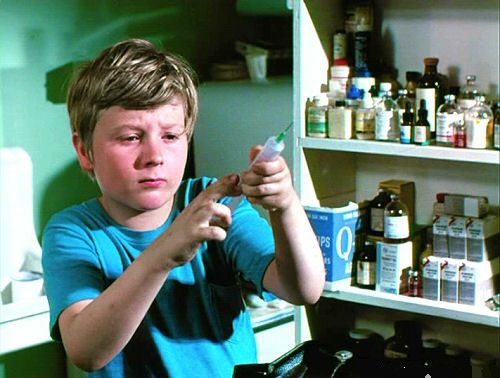
In this loose adaptation of To Kill a Mockingbird, coming of age in a small town and a lesson about the moral complexities of good and evil is presented as a cautionary tale about the potential complications involved in infecting Satan-worshipping hippies with the blood of a rabid dog placed inside meat pies. An effective infection thriller, precursor to the superior The Crazies (director David Durtson even calls out George Romero in one of the dvd documentaries), Blood opens with the aforementioned cult increasing the population of Valley Hills from 40 to 48. After a few helpings of rabies pie, they set about decreasing it to zero through machete decapitations, spine-to-mouth impalement, wooden stake to pregnant belly and electric knife fu. There's obvious silliness (the frothing infected look like they've indulged in too many root beer floats) but also the kind of inspired weirdness unique to drive-in movies. Hydrophobia - which gets an expositional scientific rundown tailored to fit the plot - is a neat substitution for the zombie-disease genre: for one, the tainted are repelled by water rather than fire. Lynn Lowry, of The Crazies, Shivers and Lloyd Kaufman's masturbatory fantasies debuts as a mute member of the contaminated cult.
10.20.06. Hellraiser.
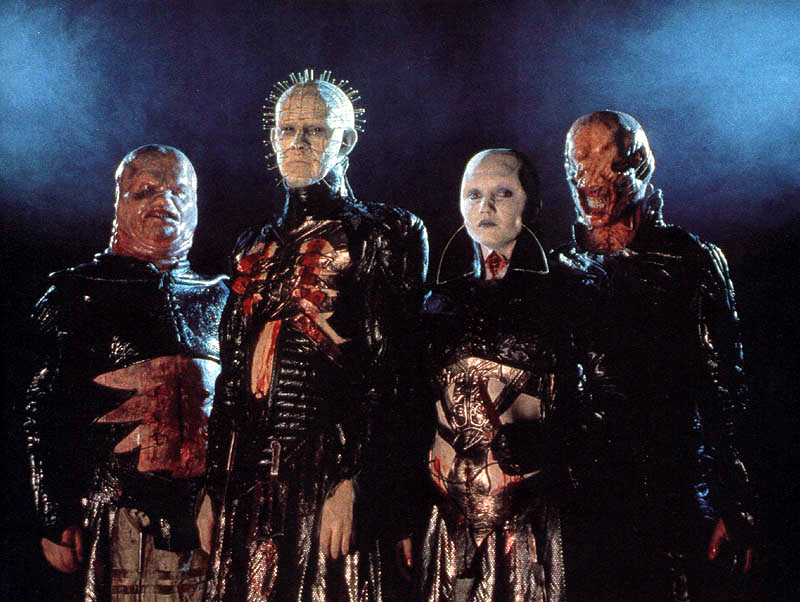 Hellraiser was one of those things you're just aware of, and I've never been compelled to actually watch any of the movies until now. It just got to a point where I couldn't say "I don't like it" without seeing it. I'm not big on Clive Barker, his stuffy, Lovecraft-liftin' mythology and sweaty-shirtless-dude subgenre of horror films in general: I liked Candyman, but I don't think Nightbreed - apart from Cronenberg's performance and the Danny Elfman score - or Lord of the Illusions can be enjoyed by anyone (and the less said about Transmutations and Rawhead Rex the better.) That aside, this first in the Pinhead cycle of films is predictably humorless and dated, but features some of the best make-up work of any gory 80s flick and several enjoyably outlandish Barker set-ups, such as the juxtaposing of rough sex with the gruntal forcing of a mattress up a flight of stairs. And it's Clive Barker rough sex: the kind that feels out of a grocery store romance novel and would descriptively find use of the word "loins." It's nice to see Andy Robinson in a film not directed by Don Siegel, and the underplaying of Pinhead and his "Cenobites" is something the 500 sequels probably don't exercise.
Hellraiser was one of those things you're just aware of, and I've never been compelled to actually watch any of the movies until now. It just got to a point where I couldn't say "I don't like it" without seeing it. I'm not big on Clive Barker, his stuffy, Lovecraft-liftin' mythology and sweaty-shirtless-dude subgenre of horror films in general: I liked Candyman, but I don't think Nightbreed - apart from Cronenberg's performance and the Danny Elfman score - or Lord of the Illusions can be enjoyed by anyone (and the less said about Transmutations and Rawhead Rex the better.) That aside, this first in the Pinhead cycle of films is predictably humorless and dated, but features some of the best make-up work of any gory 80s flick and several enjoyably outlandish Barker set-ups, such as the juxtaposing of rough sex with the gruntal forcing of a mattress up a flight of stairs. And it's Clive Barker rough sex: the kind that feels out of a grocery store romance novel and would descriptively find use of the word "loins." It's nice to see Andy Robinson in a film not directed by Don Siegel, and the underplaying of Pinhead and his "Cenobites" is something the 500 sequels probably don't exercise.
10.21.06. Cannibal Holocaust.
Curare-dipped darts, skeletons with some of the eye still in there, muskrat massacres, force-fed cocaine, ritualistic stone rapes in the mud, live executions, people impaled, fetuses torn out, body parts amputated and heads decapitated - despite the surprising lack of any actual cannibalism, Ruggero Deodata's infamous mondo film (the only one that needs defending from both Thomas Jefferson and George Santayana) is not a healthy one. It's not a very good one either: despite its reputation, Holocaust is alienated from other giallo films not by its tastelessness but its artlessness. It's technically squalid - I understand the sound being mucky in the Green Inferno jungle scenes, but the New York scenes as well?
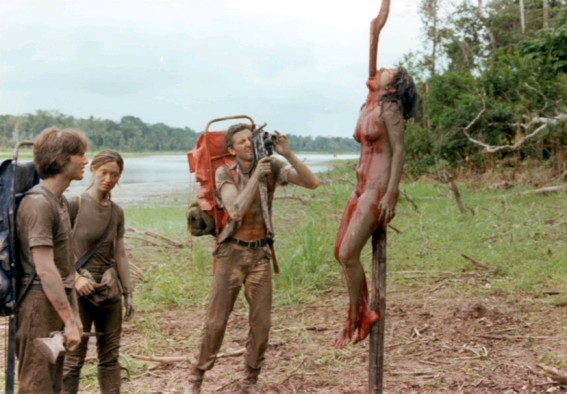
The premise is fine, but the attempt at weighing the savagery of the film crew against the normally docile natives as some sort of commentary on Vietnam or human nature is asinine (it's funny that Deodata was mentored by Roberto Rossellini - this feels like the kind of horror movie Rossellini would have made.) Character-wise, there has to be some protagonist worth rooting for in a horror movie and, after seeing the cast mutilate a turtle, you can't wait for them to receive their comeuppance. And the gimmick of trying to market it as a snuff movie, or the footage as being real (ripped off years later by The Blair Witch Project) just makes it impossible to defend the producers' integrity at all. Well, maybe I'm just jealous - I'd love to be arrested for a movie I made and have it banned in eight countries.
10.22.06. The Hills Have Eyes (1977).
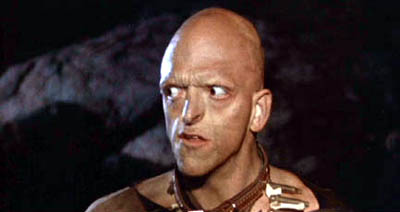
Funny about radiation: it can result in a Spider-man, or in a family of feral baby-eating nuclear geeks. Flip of the cosmic coin. In Wes Craven's film, the latter clan targets a trailer of traveling family members from Cleveland who've had the misfortune of running off the road in the middle of the desert. The movie is similar to other horror films of the same country/civilization dichotomy, and that's where the problems lie: it isn't as good or metaphorically potent as something like Texas Chain Saw Massacre or Deliverance because the motivations behind the attackers' siege is based on very basic primal urges (read: they're hungry, they need to eat.) The resultant retaliation of the family, the prevalent thematic fixation of Craven's early films, therefore becomes dramatically anticlimatic and leaves the third act largely weightless. In aesthetic terms, the film has dated much worse than 'Saw, for example: the prosthetics and "mutant" work on the hill people looks lame and unconvincing (Michael Berryman, the iconic breakout of the film as Brother Pluto, is the exception, although his character seems more dull-witted than dangerous.) I wonder if the remake is any sort of improvement...
<<click here for 10/23/6 - 11/1/6>>
home about contact us featured writings years in review film productions
All rights reserved The Pink Smoke © 2008